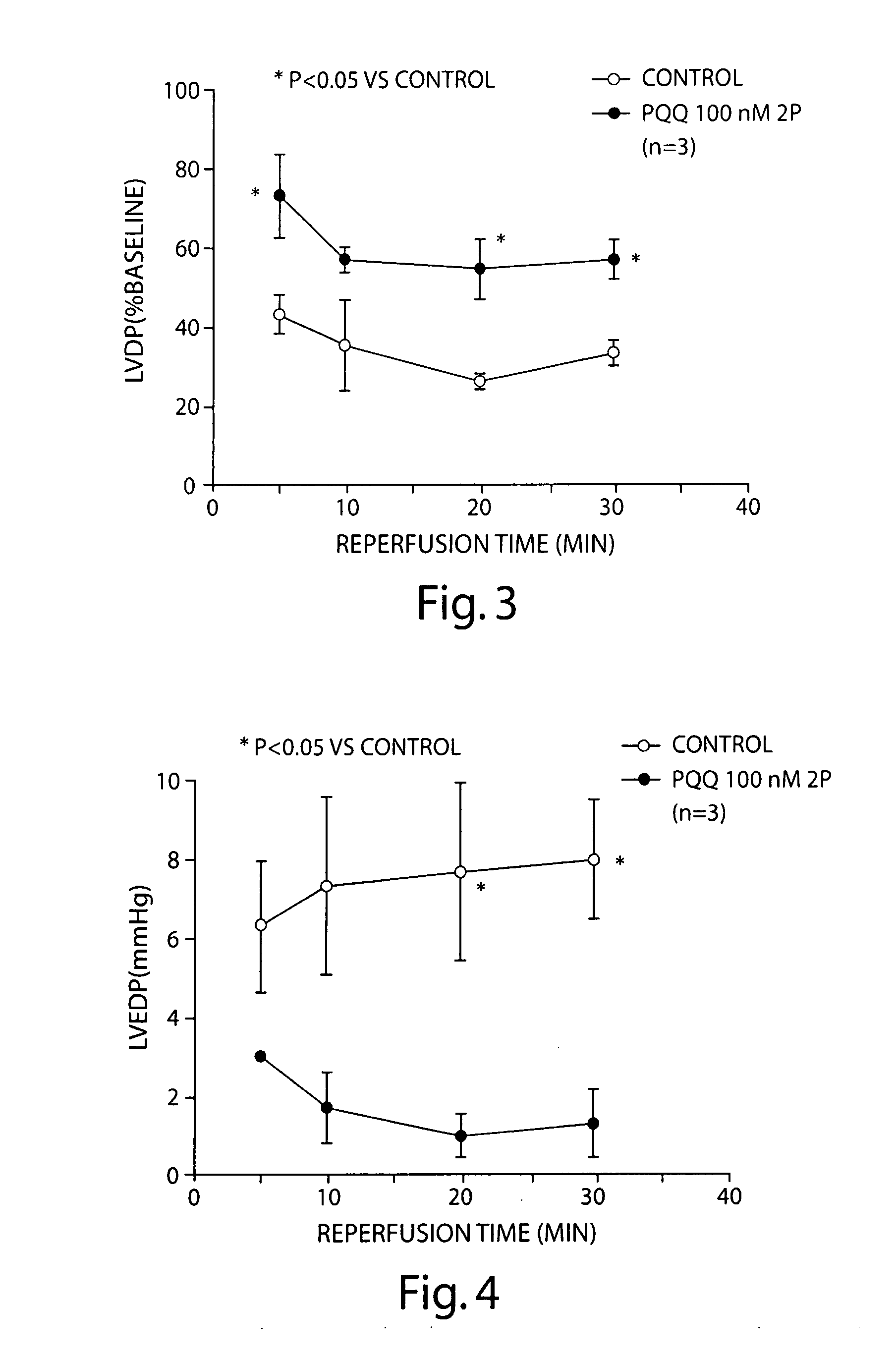Pyrroloquinoline quinone drugs and methods of use thereof
a technology of pyrroloquinoline and quinone, which is applied in the direction of biocide, drug composition, cardiovascular disorder, etc., can solve the problems of reduced immune response, weakened skin, and several tissue injuries, and achieve the effect of reducing kidney toxicity
- Summary
- Abstract
- Description
- Claims
- Application Information
AI Technical Summary
Benefits of technology
Problems solved by technology
Method used
Image
Examples
example 1
In Vitro Studies of PQQ Preservation of Cardiac Myocyte Viability
[0209] An in vitro model of cultured adult cardiac mouse myocytes was developed to study cardioprotection by PQQ. These cells are viable in culture for up to 48 hours at a physiologic pH and consist of >90% rod-shaped cells. These cells can be used readily for determination of cell viability by trypan blue exclusion, and for biochemical, immunochemical, and molecular studies. In this model, approximately 35% of the cells die when exposed to 0% oxygen in a hypoxia chamber for 2-3 hours. As shown in FIG. 1, 1 μM PQQ added 1 hour before subjecting the cells to severe hypoxia (0% oxygen for 2-3 hours) produces a significant increase in the proportion of viable cells as indicated by trypan blue exclusion. A higher concentration of PQQ (100 μM) is highly toxic under normoxic conditions as evidenced by 100% cell death. FIG. 2 demonstrates that 1 μM PQQ protection against hypoxia-induced cell death is not inhibited by 10 μM 5...
example 2
Ex Vivo Studies of PQQ Preservation of Cardiac Function
[0210] Ex vivo studies were performed using an isolated mouse heart preparation employing the Langendorff technique. In this approach, the heart is removed and mounted on a perfusion apparatus in which drugs can be given via an aortic cannula. The heart is paced at a constant rate, and left ventricular developed pressure [LVDP; left ventricular systolic pressure minus left ventricular end-diastolic pressure], left ventricular end-diastolic pressure [LVEDP], and the maximum positive and negative first derivatives of left ventricular pressure [+dP / dtmax and −dP / dtmax] are recorded. The heart is equilibrated for 20 min. After drug or vehicle is infused, the heart is subjected to 20 min of ischemia [coronary flow completely stopped] followed by 30 min of reperfusion. Coronary sinus flow as a reflection of coronary blood flow is also measured. This protocol leads to severe myocardial injury as measured by hemodynamic parameters.
[02...
example 3
PQQ Preservation of Oxidatively Stressed Cells
[0214] Cultured cardiac myocytes are subjected to oxidative stress by in vitro administration of H2O2. Two studies are done, one in which PQQ is added in concentrations between 10 nM and less than 10 μM to cardiac myocytes, after which H2O2 is added. In the other study, cardiac myocytes are subjected to insult in vitro administration of H2O2 for two hours, after which PQQ is added in concentrations between 10 nM and less than 10 μM. In both studies, PQQ is found to be protective.
PUM
| Property | Measurement | Unit |
|---|---|---|
| molar ratio | aaaaa | aaaaa |
| mole fraction | aaaaa | aaaaa |
| mole fraction | aaaaa | aaaaa |
Abstract
Description
Claims
Application Information
 Login to View More
Login to View More - R&D
- Intellectual Property
- Life Sciences
- Materials
- Tech Scout
- Unparalleled Data Quality
- Higher Quality Content
- 60% Fewer Hallucinations
Browse by: Latest US Patents, China's latest patents, Technical Efficacy Thesaurus, Application Domain, Technology Topic, Popular Technical Reports.
© 2025 PatSnap. All rights reserved.Legal|Privacy policy|Modern Slavery Act Transparency Statement|Sitemap|About US| Contact US: help@patsnap.com



